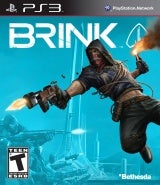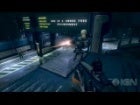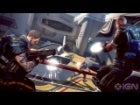On What Brink Is
Paul Wedgewood, Splash Damage CEO: The short answer is that it's obviously a brand-new title from Bethesda Softworks, the guys who made Morrowind, Oblivion, Fallout 3. Designed and developed by my studio, Splash Damage, and built on id technology. We're the guys that created the Enemy Territory franchise of games, starting out with Wolfenstein: Enemy Territory and then Enemy Territory: Quake Wars for the PC. Not the PS3 or 360 versions of that game.
The game itself, as you know, takes place on an immense artificial city at sea, that was built as part of a contemporary green vision, and it's gone through this interesting sort of history between now and 2045, where initially it has tons of funding from billionaire philanthropists, it's constructed as this microcosm of a sustainable future just off the coast of San Francisco. But it runs short of funding pretty quickly they start turning it into a kind of 10-star hotel to raise funds, and that works for a while, but they realize that the most profitable root is to tow it into international waters, where governments and corporations can do research that they wouldn't necessarily be able to do.
It's not all massively contentious stuff, and that works pretty well, but around 2032, the Ark just suddenly loses contact with the rest of the world. Almost overnight. And refugees start to arrive from nearby atolls that have been flooded, and there's this belief that the rest of the Earth is underwater and there's this one surviving city. Which is fine, except that more and more refugees start to arrive. Initially they're referred to by the original founders as "guests," quite politely, but we go about ten years, the refugee population has grown massive, to around 10,000, and they've had to repurpose them. Because of course, previously energy was at a premium, food was at a premium, now space, physical space is.
They repurpose the dock yard -- this is the location where the wealthy founders kept their valuable and sentimental belongings. It was fully roboticized, like a really cool facility, but it's repurposed as dormitories for the refugees. Over the subsequent 10 years, you have a whole new generation of people born on the Ark that have never seen land, that have never been near anything else. What starts off well-intentioned, as just a good location to group a large number of people, just descends into a shantytown. That's one of the levels that we give the demo in, Container City, which is clearly inspired by things like the favelas in Rio de Janeiro. At the other end of the scale, though, you still have the wealthy founders, with more resources than they need, defended by their security forces. So resistance cells start popping up, just fighting, they believe, for a fairer distribution of resources, against what they perceive to be a repressive security force.

On Factions and the Decreased Number of Roles in Brink
Paul Wedgewood: In Brink, what marks it out as different from most single-player games, is the fact that you don't just take on the role of, for instance, one of the resistance members, and then fight throughout the entire campaign against the security. You can fight through the entire game with the security as well. Everything that they do, and the story that you progress through, is unique to those two factions. You have the resistance, their gear is all begged, borrowed, and stolen, and it goes down to all of your effects, like if you fire a sub-machinegun from the resistance perspective, it'll sound like something that isn't very well-maintained.On Brink's Dynamically Changing Objectives
Anyway, what you do in the game is you take on a combat role that suits your preferred playing style. I know from your previews and reviews and stuff, you're fairly familiar with the class structure. We've been doing that ourselves since our mod-making roots on Quake III, when we did Quake III Fortress originally. We've refined that down to four combat roles that we think work really well. Which is not bad, when we started with 10 back in 1999. Over the course of our games we've continuously realized that you actually need less and less stuff. It's more interesting to give the player the opportunity to configure a kit and a loadout and the types of weapons and things that they want to carry. It's our job to make sure that balances out well. So you take a combat role that supports your preferred playing style, but instead of just running around deathmatching or capturing flags, which is all fun, I did it for years at tournament level myself, in our game you pursue specific military objectives.
Paul Wedgewood: Okay, yeah, that's obviously on a much grander scale. In Brink you pursue military objectives as part of a coordinated team, but where we've made really significant advances is this dynamically generated mission system. What this means is that irrespective of the combat role that you're playing, the game is able to generate a number of missions, six or seven, based on that combat role, the abilities that you've unlocked, the weapons that you're carrying and what you're best suited to, your location on the battlefield, the status of the objectives on the battlefield, and what everybody else is doing.
At any given point on the map, you've got this branching narrative structure -- or it's better understood as a branching gameplay structure -- that lets you choose something, and then you get an arrow that tells you the route to take. And obviously if you're in front of this huge target that you're trying to destroy, and if I'm playing Operative, as I do in the demo [at QuakeCon], I might go off and do an interrogation mission. Or I could go and hack into a back door and open up an additional route, I could hack into a command post, I could go and try to disable some stuff. If I was playing Soldier, however, my job might be to go and destroy the gate. And if I was playing Engineer, I'd be putting up defense turrets, planting landmines, securing our position.

On Persistent Character Development and Multiplayer in Brink
Paul Wedgewood: So [the objective-based style] of gameplay is compelling, but with our iterations of that type of thing in the past, at the end of the third round everything resets back to zero. Because we were frankly too concerned about unbalancing the battlefield. Well, at the beginning of 2008, we had a guy called Richard Ham, who was the lead game designer behind Fable II, he was also the co-creator of Syphon Filter on the PlayStation, the best-selling shooter on the PlayStation. He presented this really compelling set of ideas for the kind of branching narrative/gameplay stuff I talked about before, but also rigorous anti-griefing safeguards, more advanced player matchmaking.
So what we're able to achieve, I think for the first time in the history of shooters, is to truly blur the lines between the offline experience and the online experience, while providing you with a character that you advance persistently as if you were playing an MMO. For example you have your character, and let's say for example your friend's bought the game. He's played all the way through the resistance and security campaigns, he's unlocked a bunch of cool stuff, including the ability to configure the way that he looks. He's online and his badass status is reflected to everybody that can see him. He suggests that you get the game, so you get hold of a copy, and you're two-three hours through your campaign. We have full drop-in and out support for up to seven friends to join you on the fly at any point that you like and bring their characters, and everything that they've unlocked and all of those attributes with them. Then the game tracks your progress, and at about two-thirds in we can tell you can deal with being outflanked... our AI isn't just dumb scripted popping up from behind cover AI, it'll run around and kick your ass if you give it the chance, and you learn to play, frankly, the way that you're going to have to by the time you get online anyway.





